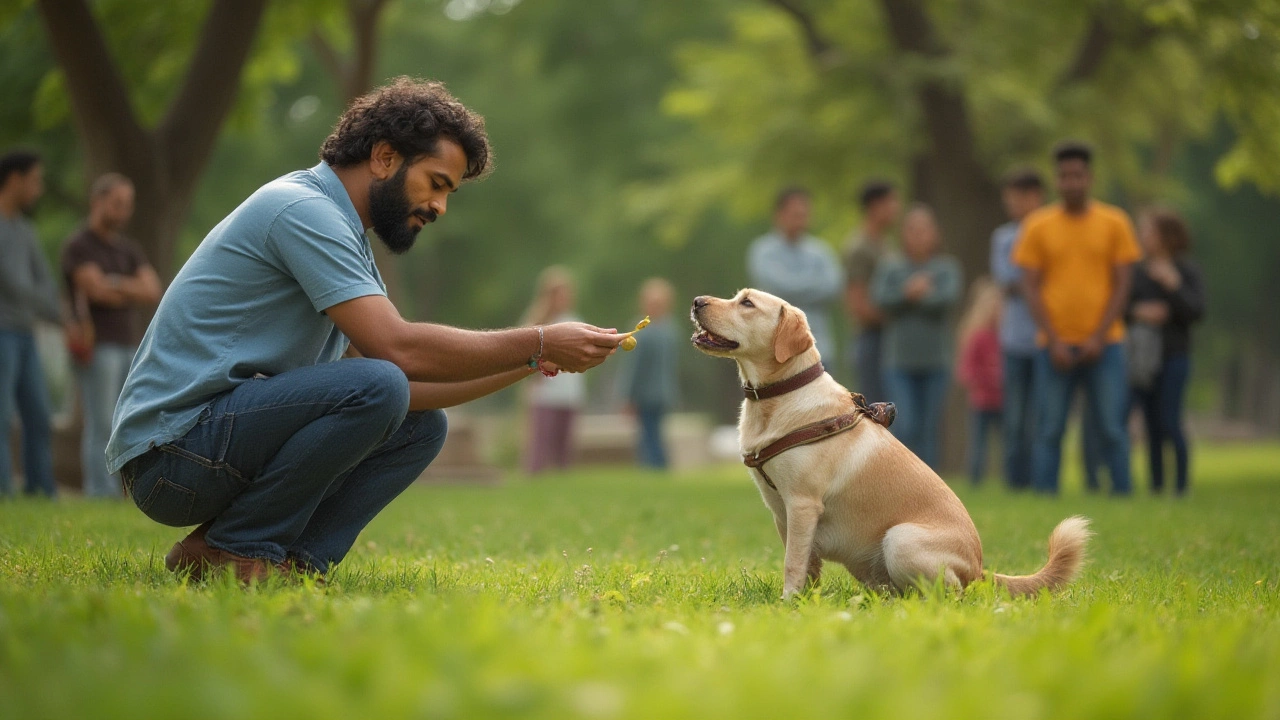
Picture this: you're out at the park, and that one guy's calling his dog like a broken record—while his furry sidekick sprints toward the ice cream stand. You wonder, 'Do the pros wrestle with stubborn pups like the rest of us? Do they pull out the secret weapon: the shock collar?' There's just as much drama in the world of dog training as in any morning at my place, with Rowan and our two dogs bouncing around, outsmarting every baby gate known to humankind.
What Are Shock Collars and Why Are People Talking About Them?
Walk through any pet store and you’ll see a dizzying display of devices—leashes, harnesses, clickers, and, jammed on a shelf, shock collars (often dressed up as 'e-collars'). These collars deliver an electrical pulse to a dog's neck. The buzz ranges from something barely noticeable to, well, not so nice. Manufacturers claim they help curb unwanted behaviors, but let’s get real—there’s way more to the story.
Shock collars usually come with a remote so the handler controls when the stimulation happens. Some collars also beep or vibrate before they zap, supposedly warning the dog. The idea? A quick, uncomfortable jolt teaches the dog to steer clear of certain behaviors, like barking nonstop or charging after the neighbor’s cat.
But here's an eyebrow-raiser: the controversy around these collars isn’t new. In 2023, a survey by the American Veterinary Society of Animal Behavior (AVSAB) found that over 70% of certified animal behaviorists advised against using shock collars altogether. Yet, you’ll find some trainers on YouTube swearing by their 'e-collar programs.'
So, what are the arguments? On one side, fans say e-collars—when used properly—offer clearer communication and can 'save' difficult dogs from being surrendered or worse. On the other, critics argue that the risk of fear, pain, and even aggression is too high. The data isn’t all fluffy either: a 2021 University of Lincoln study followed 63 dogs split into three groups (positive reinforcement, e-collar, and controls). The e-collar group didn’t outperform the others and showed more signs of stress.
Do Real Professional Dog Trainers Use Shock Collars?
This is the question that splits the dog training world clean down the middle. There’s no secret handshake among trainers or a single dog-training Bible everyone swears on. Instead, methods are shaped by different philosophies, local laws, and personal ethics.
In the United States, some trainers—especially those focused on police, hunting, or competition dogs—do use e-collars. You’ll find big names in this camp, like Cesar Millan or Jeff Gellman, who defend their use of remote collars as tools of last resort, always under “supervised, humane conditions.” Their argument: some dogs, particularly those with dangerous behaviors, may need interruption powerful enough to snap them out of that mindset.
But there’s a catch—not all trainers agree, and the professional crowd is leaning the other direction. Organizations like the Certification Council for Professional Dog Trainers (CCPDT) and the Association of Professional Dog Trainers (APDT) strongly caution against using pain, intimidation, or fear. In 2022, the APDT published a position statement urging trainers to rely on positive reinforcement first, and only consider aversive tools like shock collars if there are no other options—then only in consultation with a veterinarian or certified behaviorist.
Globally, the picture is even more varied. In countries like Norway, Sweden, and Germany, shock collars are outright banned. Trainers there make do with clickers, treats, and patience. There’s a shift in the UK, too; Wales banned electric collars in 2010, and Scotland followed up with a ban in 2018. New Zealand cracked down in 2021, restricting sales to professional trainers under special circumstances. You don’t see pros in these places reaching for a shock collar, period.
For anyone interested, here’s a quick look at where shock collars land around the world:
| Country | Shock Collar Legal Status |
|---|---|
| United States | Legal (no federal ban) |
| United Kingdom | Banned in Wales (2010) and Scotland (2018); Still legal in England |
| Germany | Banned |
| Norway | Banned |
| New Zealand | Restricted to professionals |

How Do Professional Trainers Approach E-Collar Training?
Trainers who do use e-collars, or 'stim collars,' don’t just slap them on and call it a day. There’s a process. Reputable trainers start by teaching basic behaviors through positive reinforcement—think treats, praise, and toys. The e-collar only comes in after the dog knows the behaviors and just isn’t consistent with them.
Here’s the difference: the best trainers use the lowest possible setting, watching for a tiny head tilt or ear flick that says, “Yep, I felt that.” They’re not out to scare or punish the dog; they’re nudging attention back to the task. Many follow a “tap, don’t zap” philosophy—if the dog hesitates, redirect with a gentle pulse, then reward compliance immediately, building positive associations.
Pro tip: Owners sometimes think using a higher setting or repeated shocks means faster results. It’s not true. That’s a great way to freak out your pup, damage trust, and maybe even make the problem behavior worse. The pros know to watch for signs of stress—lip licking, yawning, looking away, tail tucked—and back off if they see them.
There’s more to it, though. Professional trainers tailor their techniques to the dog’s temperament, health, and life history. If a dog’s anxious or has a history of trauma, most trainers stay far away from anything that might remind them of past scares. Instead, they might up their positive reinforcement or look for creative management solutions so the dog never gets to practice the bad behavior in the first place.
Here’s a step-by-step look into how a balanced trainer might use an e-collar:
- Teach commands (sit, stay, recall) using treats and praise only.
- Introduce the e-collar at its lowest setting to let the dog get used to the vibration or tickle, not a jolt.
- Pair the remote collar with known cues—if the dog ignores the recall, a gentle tap draws their attention back.
- Reward correct behavior right after the collar cue, reinforcing trust and clarity.
- As the dog progresses, use the collar less and rely on verbal cues and gestures.
Still, the top trainers—the ones you’d trust your dog with—say this: shock collars are training tools, not shortcuts. If you yank a collar out of the box and use it to punish, you’re almost guaranteed a mess. Training, no matter the method, means patience, timing, and reading your dog like your favorite book.
The Shift Toward Positive Reinforcement in Dog Training
Here’s the thing: dog training has come a long way. What my granddad might’ve done with a rolled-up newspaper has given way to clickers and frosted beef liver treats. The shift to positive reinforcement—rewarding good behavior instead of punishing mistakes—isn’t just a trend; it’s grounded in solid research.
The science is in: reward-based methods work. The American Veterinary Medical Association (AVMA) and the Royal Society for the Prevention of Cruelty to Animals (RSPCA) both recommend positive reinforcement as the first-line approach. Dogs trained with kindness learn faster, stay emotionally healthier, and actually want to work with you. Rowan and I once switched to all-positive methods with our anxious rescue, and the turnaround was night-and-day. She stopped hiding from the leash and started wagging at training time.
Positive training isn’t just for beginners or 'easy' dogs. Seasonal trainer Denis Fenzi—who competes at the highest levels of dog sports—runs her entire program without ever using force or aversive tools. She’s got a national fanbase to show for it. And when you stack positive training clinics against collar-based workshops, attendance numbers don’t lie—owners are moving toward reward-based classes.
But here’s an honest take: not every dog, every trainer, or every situation lines up perfectly for treat-based training. Some dogs are bred to work off-leash or in high-drive situations. Sometimes, life puts you in a place where you can’t wait weeks for perfect recall learning curves (think: cattle dogs and livestock, or service dogs near traffic). That’s when experienced trainers might consider e-collars—as a last resort, and always with strict professional oversight.
There are plenty of ways to teach your dog good behavior at home, too. Here are a few starter tips for positive training:
- Find the treats or toys your dog loves the most—experiment a little!
- Keep training sessions short and fun—think 3-5 minutes, three times a day.
- Use a marker word (“Yes!”) or a clicker to tell your dog exactly when they get it right.
- Gradually add distance, distractions, and duration as your dog gets better.
- If your dog struggles, take a step back—make it easier, not harder, to get it right.
Consistency is your best friend. Set clear boundaries, reward generously, and build a relationship based on trust—not fear or intimidation.

Should You Use a Shock Collar? Making an Informed Decision
Here’s the simple truth: there’s no “one-size-fits-all” answer. Every dog is different, every owner has unique goals, and the right approach balances results with the dog’s quality of life. What matters is making a choice you can stand by, knowing it’s grounded in evidence and respect for your dog.
If you’re thinking about a shock collar, ask yourself: Have I tried positive reinforcement first? Are the behavior issues putting anyone in danger? Have I talked to a professional—ideally one certified in force-free methods—about my options? Many trainers will do a consultation or even evaluate your dog remotely if you can’t find someone nearby.
Remember to double-check your local laws. Some places make it a crime to use or even possess a shock collar, and in others, the devices are totally unregulated. For those insisting a shock collar is the only way, it’s critical to invest in professional coaching and to know that good trainers will teach you how to use it humanely, never punitively.
Here's a quick safety checklist if you go down the e-collar route:
- Work with a certified trainer, not just YouTube videos.
- Always use the lowest effective setting—never crank it up out of frustration.
- Watch your dog's body language for signs of fear or stress.
- Never leave the collar on for long periods or unsupervised.
- Pair collar cues with positive reinforcement every time.
If you stick with positive methods, pat yourself on the back—you’re in good company. The world’s top animal behaviorists, rescue groups, and a growing number of dog owners are swapping old-school tools for clickers and cookies. There’s less risk, more tail wags, and nobody wakes up wondering where the trust went.
Training your dog should be about building a partnership, not a power struggle. Whether you reach for a treat pouch or consult a pro about e-collars, make sure your dog’s well-being comes first. That’s how the pros do it, collars or not. If you want a happy, eager sidekick—one that tunes into you at the park, even with squirrels sprinting—science says it’s all about positive vibes and clear communication. The rest? That’s just static.





